 Traffic Signs
Traffic Signs
MAchine Learning and Intelligent System
Road Signs Classification with Machine Learning
Name & SURNAME : Adib RACHID & Mokhles BOUZAIEN
Introduction
A car company’s commercial project would be a combination of detection and classification of road signs inside the car software. This project is highly recommended for autonomous cars and even to automate some car functions such as alerting drivers on a limit speed or other road signs. However, in this project, the objective will be to work on only classifying road signs into their correct classes ex: speed limit, no stopping, no entry, etc. The difficulty can increase by knowing more information about these classes ex: speed limit value, maximum height value, etc. and then, by detecting the road signs as a further step. This problem can be considered as a computer vision problem so deep learning may be required to solve the classification in order to extract features from the images and use them to correctly classify the image to its exact class.
# IMPORTS
from __future__ import absolute_import, division, print_function, unicode_literals
import utils
import preprocessing as pre
import numpy as np
import time
import os
import numpy as np
import matplotlib.pyplot as plt
import random
from pathlib import Path
import cv2
import NN as nn
Exploring Data
The first step, is to explore the data we are going to use, i.e. the total number of classes, the number of training samples and the number of testing samples.
Then, we will create two dataset instances using the Dataset class defined in the NN module.
# Get information about data
data_dir = "data"
train_data_dir, train_labels_path = "data/gtsrb-german-traffic-sign/Train", "data/gtsrb-german-traffic-sign/Train.csv"
test_data_dir, test_labels_path = "data/gtsrb-german-traffic-sign/Test", "data/gtsrb-german-traffic-sign/Test.csv"
utils.data_info(data_dir, train_data_dir, test_data_dir)
total classes 43
total train 39209
total test 12630
# Create training and testing datasets
train_data_set = nn.Dataset(train_data_dir, train_labels_path, data='train')
test_data_set = nn.Dataset(test_data_dir, test_labels_path, data='test')
# Class labels
classes = np.unique(train_data_set.labels)
print(classes)
[ 0 1 2 3 4 5 6 7 8 9 10 11 12 13 14 15 16 17 18 19 20 21 22 23
24 25 26 27 28 29 30 31 32 33 34 35 36 37 38 39 40 41 42]
# Retrieve the metadata such as the sign corresponding to each class
meta_data_dir = Path("data/gtsrb-german-traffic-sign/Meta")
meta_data_set = []
for _class in classes:
img_path = meta_data_dir/(str(_class) + ".png")
img = cv2.imread(str(img_path))
img = cv2.cvtColor(img, cv2.COLOR_BGR2RGB)
meta_data_set.append(img)
# Plot different classes
fig, axes = plt.subplots(4, 11, sharex=True, sharey=True, figsize=(20,8))
axes = axes.flatten()
for img, _class, ax in zip(meta_data_set, classes, axes):
ax.imshow(img)
ax.axis('off')
ax.set_title("Class: " + str(_class))
plt.show()
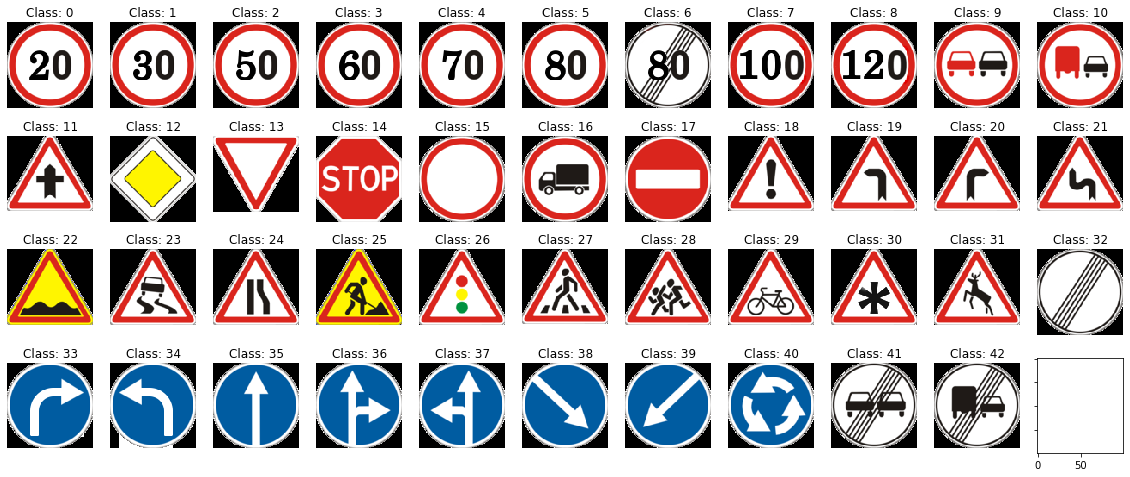
# Let's have a look at the distribution of the data though the differents classes
# This will be useful later ...
utils.classDistribution(train_data_set.labels)
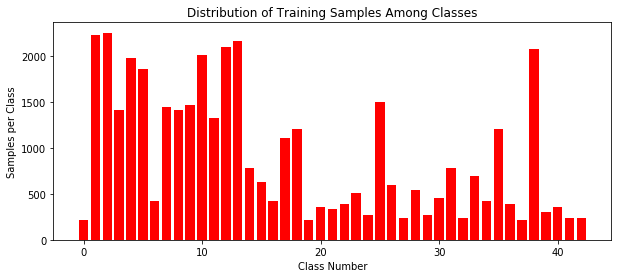
# To explore the data in more details, we choose to represent each image width and height on a scatter plot
ws_train, hs_train = list(), list()
ws_test, hs_test = list(), list()
for img in train_data_set.X:
ws_train.append(img.shape[0])
hs_train.append(img.shape[1])
for img in test_data_set.X:
ws_test.append(img.shape[0])
hs_test.append(img.shape[1])
plt.figure(figsize=(16, 6))
plt.subplot(121)
plt.scatter(ws_train, hs_train, s=1, marker='.')
plt.xlabel('width')
plt.ylabel('height')
plt.xlim(0, 250)
plt.ylim(0, 300)
plt.title('Distribution of Image Sizes of The Training Dataset')
plt.subplot(122)
plt.scatter(ws_test, hs_test, s=1, marker='.', c='r')
plt.xlabel('width')
plt.ylabel('height')
plt.xlim(0, 250)
plt.ylim(0, 300)
plt.title('Distribution of Image Sizes of The Testing Dataset')
Text(0.5, 1.0, 'Distribution of Image Sizes of The Testing Dataset')
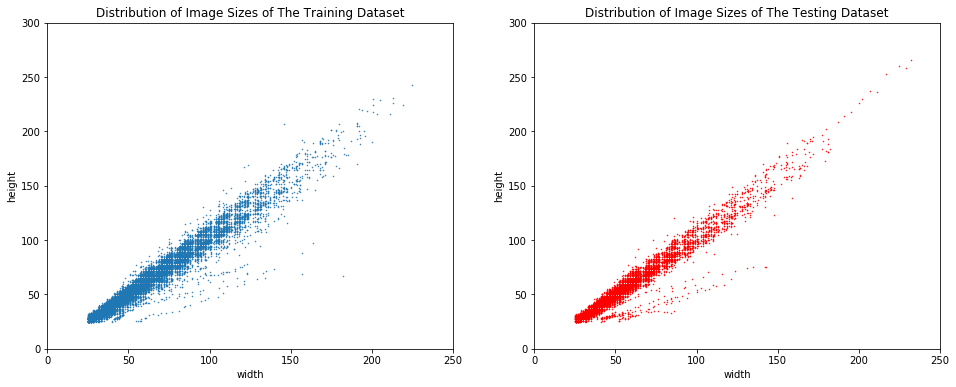
# Randomly pick and show 22 images from the tarining data
random.seed(8)
rand_imgs = random.sample(list(train_data_set.X), 22)
utils.plotImages(rand_imgs)

Data Preprocessing
# Rshaping to 32x32 images and converting to grayscale
reshaped_train_images = []
for image in train_data_set.X:
dst = pre.eqHist(image)
dst = pre.reshape(dst, 32)
reshaped_train_images.append(dst)
train_data_set.X = reshaped_train_images
reshaped_test_images = []
for image in test_data_set.X:
dst = pre.eqHist(image)
dst = pre.reshape(dst, 32)
reshaped_test_images.append(dst)
test_data_set.X = reshaped_test_images
# Now, all samples have the same size
random.seed(8)
utils.plotImages(random.sample(train_data_set.X, 22), cmap='gray')

Training a NN model
For this model, the input is a $d\times1$ vector containing the values of the image pixels (from 0 to 255 before normalization).
reshaped_train_images = []
for image in train_data_set.X:
# convert each image to a vector
dst = image.reshape(-1,1)
reshaped_train_images.append(dst)
# normalize in order to get values between 0 and 1
train_data_set.X = np.asarray(reshaped_train_images) / 255.
reshaped_test_images = []
for image in test_data_set.X:
# convert each image to a vector
dst = image.reshape(-1,1)
reshaped_test_images.append(dst)
# normalize in order to get values between 0 and 1
test_data_set.X = np.asarray(reshaped_test_images) / 255.
# Create the MLP model
mlp = nn.MLP("NN.dat", train_data_set, print_step=1, verbose=1)
# TRAINING THIS MODEL COULD LAST FOR HOURS
mlp.train(n_epochs=5, learning_rate=1, decay=1.)
mlp.make_plot()
mlp.setdataset(test_data_set)
mlp.print_accuracy()
Training a CNN model
from tensorflow.keras.models import Sequential
from tensorflow.keras.layers import Dense, Conv2D, Flatten, MaxPooling2D
from tensorflow.keras import optimizers
# Linear stack of layers.
model = Sequential()
model.add(Conv2D(32, (3,3), activation='relu',
input_shape=(32, 32, 1))) # the input samples are images of size 32*32 with one channel
model.add(MaxPooling2D((2, 2)))
model.add(Conv2D(64, (3, 3), activation='relu'))
model.add(MaxPooling2D((2, 2)))
model.add(Conv2D(64, (3, 3), activation='relu'))
model.summary()
Model: "sequential"
_________________________________________________________________
Layer (type) Output Shape Param #
=================================================================
conv2d (Conv2D) (None, 30, 30, 32) 320
_________________________________________________________________
max_pooling2d (MaxPooling2D) (None, 15, 15, 32) 0
_________________________________________________________________
conv2d_1 (Conv2D) (None, 13, 13, 64) 18496
_________________________________________________________________
max_pooling2d_1 (MaxPooling2 (None, 6, 6, 64) 0
_________________________________________________________________
conv2d_2 (Conv2D) (None, 4, 4, 64) 36928
=================================================================
Total params: 55,744
Trainable params: 55,744
Non-trainable params: 0
_________________________________________________________________
model.add(Flatten())
model.add(Dense(64, activation='relu'))
model.add(Dense(43, activation='softmax'))
model.summary()
Model: "sequential"
_________________________________________________________________
Layer (type) Output Shape Param #
=================================================================
conv2d (Conv2D) (None, 30, 30, 32) 320
_________________________________________________________________
max_pooling2d (MaxPooling2D) (None, 15, 15, 32) 0
_________________________________________________________________
conv2d_1 (Conv2D) (None, 13, 13, 64) 18496
_________________________________________________________________
max_pooling2d_1 (MaxPooling2 (None, 6, 6, 64) 0
_________________________________________________________________
conv2d_2 (Conv2D) (None, 4, 4, 64) 36928
_________________________________________________________________
flatten (Flatten) (None, 1024) 0
_________________________________________________________________
dense (Dense) (None, 64) 65600
_________________________________________________________________
dense_1 (Dense) (None, 43) 2795
=================================================================
Total params: 124,139
Trainable params: 124,139
Non-trainable params: 0
_________________________________________________________________
from tensorflow.keras.utils import plot_model
plot_model(model, to_file='images/model.png', show_shapes=True, rankdir='LR')

train_data_set.X.shape
(39209, 1024, 1)
train_data_set.X = train_data_set.X.reshape(-1,32,32,1)# / 255.0
test_data_set.X = test_data_set.X.reshape(-1,32,32,1)# / 255.0
new_y = list()
for y in train_data_set.y:
new_y.append(np.argmax(y))
new_y = np.asarray(new_y).reshape(-1,1)
new_y_test = list()
for y in test_data_set.y:
new_y_test.append(np.argmax(y))
new_y_test = np.asarray(new_y_test).reshape(-1,1)
train_data_set.X.shape, new_y.shape
((39209, 32, 32, 1), (39209, 1))
model.compile(optimizer=optimizers.RMSprop(),
loss='sparse_categorical_crossentropy',
metrics=['accuracy'])
history = model.fit(train_data_set.X, new_y, validation_split=0.25, epochs=10)
Train on 29406 samples, validate on 9803 samples
Epoch 1/10
29406/29406 [==============================] - 24s 816us/sample - loss: 0.9651 - accuracy: 0.7198 - val_loss: 27.1570 - val_accuracy: 0.0568
Epoch 2/10
29406/29406 [==============================] - 22s 746us/sample - loss: 0.1340 - accuracy: 0.9606 - val_loss: 27.8668 - val_accuracy: 0.0557
Epoch 3/10
29406/29406 [==============================] - 22s 736us/sample - loss: 0.0661 - accuracy: 0.9813 - val_loss: 24.1913 - val_accuracy: 0.0541
Epoch 4/10
29406/29406 [==============================] - 22s 764us/sample - loss: 0.0380 - accuracy: 0.9886 - val_loss: 30.2046 - val_accuracy: 0.0563
Epoch 5/10
29406/29406 [==============================] - 23s 794us/sample - loss: 0.0263 - accuracy: 0.9921 - val_loss: 28.2901 - val_accuracy: 0.0568
Epoch 6/10
29406/29406 [==============================] - 27s 932us/sample - loss: 0.0173 - accuracy: 0.9948 - val_loss: 34.7405 - val_accuracy: 0.0556
Epoch 7/10
29406/29406 [==============================] - 25s 838us/sample - loss: 0.0130 - accuracy: 0.9957 - val_loss: 33.3517 - val_accuracy: 0.0555
Epoch 8/10
29406/29406 [==============================] - 23s 773us/sample - loss: 0.0113 - accuracy: 0.9965 - val_loss: 30.3522 - val_accuracy: 0.0562
Epoch 9/10
29406/29406 [==============================] - 22s 765us/sample - loss: 0.0064 - accuracy: 0.9978 - val_loss: 36.1016 - val_accuracy: 0.0569
Epoch 10/10
29406/29406 [==============================] - 24s 807us/sample - loss: 0.0070 - accuracy: 0.9981 - val_loss: 32.7518 - val_accuracy: 0.0560
# Plot training & validation accuracy values
plt.plot(history.history['accuracy'])
plt.plot(history.history['val_accuracy'])
plt.title('Model accuracy')
plt.ylabel('Accuracy')
plt.xlabel('Epoch')
plt.legend(['Train', 'Test'], loc='upper left')
plt.show()
# Plot training & validation loss values
plt.plot(history.history['loss'])
plt.plot(history.history['val_loss'])
plt.title('Model loss')
plt.ylabel('Loss')
plt.xlabel('Epoch')
plt.legend(['Train', 'Test'], loc='upper left')
plt.show()
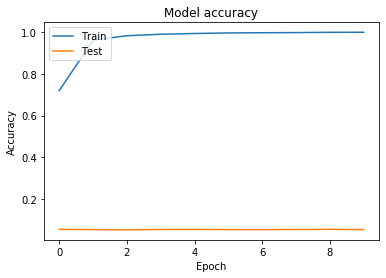
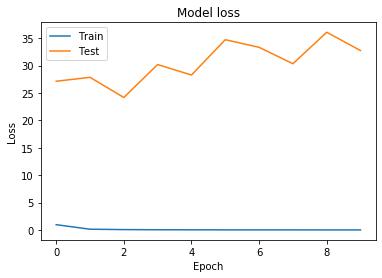
model.metrics_names
['loss', 'accuracy']
loss_and_metrics = model.evaluate(test_data_set.X, new_y_test, verbose=0)
loss_and_metrics
[8.373822529053555, 0.73198736]
# Data augmentation: generate fake data from the existing images
fake_data_dir, fake_labels_path = "data/gtsrb-german-traffic-sign/augmented/train", "data/gtsrb-german-traffic-sign/augmented/Train_augmented.csv"
fake_data_set = nn.Dataset(fake_data_dir, fake_labels_path, data='augmented', n_samples=30000)
utils.classDistribution(fake_data_set.labels)
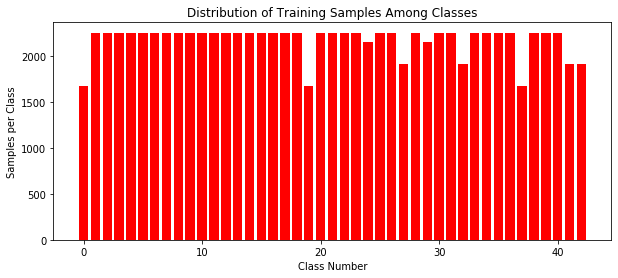
# Rshaping to 32x32 images and converting to grayscale
reshaped_fake_images = []
for image in fake_data_set.X:
dst = pre.eqHist(image)
dst = pre.reshape(dst, 32)
reshaped_fake_images.append(dst)
fake_data_set.X = reshaped_fake_images
# normalize in order to get values between 0 and 1
fake_data_set.X = np.asarray(fake_data_set.X).reshape(-1,32,32,1) / 255.
new_fake_y = list()
for y in fake_data_set.y:
new_fake_y.append(np.argmax(y))
new_fake_y = np.asarray(new_fake_y).reshape(-1,1)
# Linear stack of layers.
model_2 = Sequential()
model_2.add(Conv2D(32, (3,3), activation='relu',
input_shape=(32, 32, 1))) # the input samples are images of size 32*32 with one channel
model_2.add(MaxPooling2D((2, 2)))
model_2.add(Conv2D(64, (3, 3), activation='relu'))
model_2.add(MaxPooling2D((2, 2)))
model_2.add(Conv2D(64, (3, 3), activation='relu'))
model_2.add(Flatten())
model_2.add(Dense(64, activation='relu'))
model_2.add(Dense(43, activation='softmax'))
model_2.compile(optimizer=optimizers.RMSprop(),
loss='sparse_categorical_crossentropy',
metrics=['accuracy'])
history_2 = model_2.fit(fake_data_set.X, new_fake_y, validation_split=0.25, epochs=10)
Train on 22500 samples, validate on 7500 samples
Epoch 1/10
22500/22500 [==============================] - 17s 745us/sample - loss: 1.1806 - accuracy: 0.6726 - val_loss: 0.3273 - val_accuracy: 0.8951
Epoch 2/10
22500/22500 [==============================] - 16s 721us/sample - loss: 0.1688 - accuracy: 0.9496 - val_loss: 0.1725 - val_accuracy: 0.9475
Epoch 3/10
22500/22500 [==============================] - 18s 796us/sample - loss: 0.0664 - accuracy: 0.9792 - val_loss: 0.0559 - val_accuracy: 0.9839
Epoch 4/10
22500/22500 [==============================] - 19s 826us/sample - loss: 0.0344 - accuracy: 0.9899 - val_loss: 0.0527 - val_accuracy: 0.9844
Epoch 5/10
22500/22500 [==============================] - 17s 746us/sample - loss: 0.0221 - accuracy: 0.9932 - val_loss: 0.0460 - val_accuracy: 0.9867
Epoch 6/10
22500/22500 [==============================] - 18s 795us/sample - loss: 0.0143 - accuracy: 0.9951 - val_loss: 0.0351 - val_accuracy: 0.9897
Epoch 7/10
22500/22500 [==============================] - 17s 748us/sample - loss: 0.0098 - accuracy: 0.9969 - val_loss: 0.0278 - val_accuracy: 0.9928
Epoch 8/10
22500/22500 [==============================] - 17s 767us/sample - loss: 0.0099 - accuracy: 0.9966 - val_loss: 0.0474 - val_accuracy: 0.9896
Epoch 9/10
22500/22500 [==============================] - 17s 769us/sample - loss: 0.0073 - accuracy: 0.9976 - val_loss: 0.0605 - val_accuracy: 0.9861
Epoch 10/10
22500/22500 [==============================] - 17s 774us/sample - loss: 0.0091 - accuracy: 0.9973 - val_loss: 0.0302 - val_accuracy: 0.9927
# Plot training & validation accuracy values
plt.plot(history_2.history['accuracy'])
plt.plot(history_2.history['val_accuracy'])
plt.title('Model accuracy')
plt.ylabel('Accuracy')
plt.xlabel('Epoch')
plt.legend(['Train', 'Test'], loc='upper left')
plt.show()
# Plot training & validation loss values
plt.plot(history_2.history['loss'])
plt.plot(history_2.history['val_loss'])
plt.title('Model loss')
plt.ylabel('Loss')
plt.xlabel('Epoch')
plt.legend(['Train', 'Test'], loc='upper left')
plt.show()
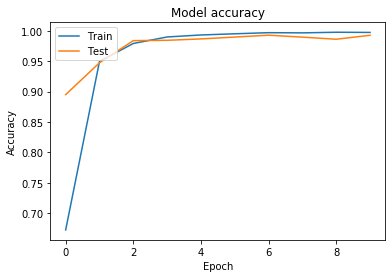
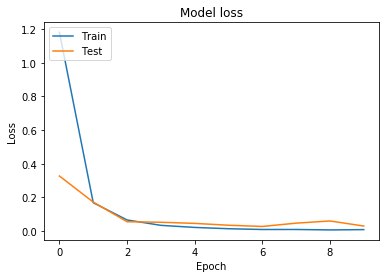
loss_and_metrics_2 = model_2.evaluate(test_data_set.X, new_y_test, verbose=0)
loss_and_metrics_2
[1.5791984968872554, 0.83032465]
For the full code, check the Gitlab repository.